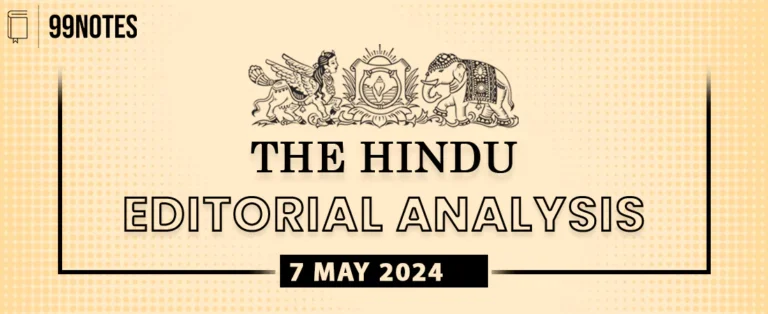14 November 2024 : Indian Express Editorial Analysis
1. A green transition for India
(Source: Indian Express; Section: The Editorial Page; Page: 14)
| Topic: GS3 – Environment |
| Context: |
| The article discusses India’s urgent need to transition to a sustainable, resilient energy economy that balances decarbonisation, economic growth, and equitable access, while attracting climate finance and fostering global collaboration. |
India’s Path to a Sustainable, Decarbonised Economy: Context and Urgency
- Amidst global uncertainty, including recent developments in the U.S. and West Asia, India faces a dual challenge: decarbonising its economy without hindering growth while attracting critical climate finance.
- With power demand predicted to nearly double by 2031-32, India requires a comprehensive, equitable energy transition to balance economic vitality with environmental resilience.
- Achieving this requires fundamental shifts that prioritize people and harness emerging business models and sustainable technology to build a resilient energy framework.
Decentralised Energy Systems: Empowering Local Solutions
- One pivotal shift is towards decentralised energy systems that can address India’s rapidly growing power needs and provide resilience against grid vulnerabilities.
- Distributed Renewable Energy (DRE) sources like rooftop solar installations offer a promising solution. However, accessibility remains an issue, particularly for lower-income households that find current pricing prohibitively high.
- Market-driven innovations, such as community solar projects, could help expand access by pooling resources and reducing individual costs, allowing India to reach its ambitious target of adding 30 GW of rooftop solar capacity.
Shifting to Operational Expenditure Models: Redefining Cost Structures
- To facilitate a smoother energy transition, India must shift its economic model from capital expenditure (capex) to operational expenditure (opex).
- This transition could enable cleaner energy solutions at scale by allowing consumers to pay for energy as a service rather than investing in costly equipment.
- Opex models, such as utility-managed community solar and district cooling systems, reduce upfront costs, promoting accessibility to cleaner energy options.
- Such approaches could extend to other areas, like sustainable mobility, by offering pay-per-use transportation options over individual vehicle ownership.
Climate-Resilient Investments: Mitigating Risks through Resilience
- The financial focus must shift towards resilient, climate-proof investments to counter the rising impacts of climate change, with 80% of India’s population residing in climate-vulnerable districts.
- Investments aimed at climate adaptation and risk-proofing infrastructure are increasingly urgent, as climate shocks at current warming levels have already underscored.
- A focus on resilience can offset long-term costs, positioning India’s infrastructure to withstand future shocks and reducing perceived risk for investors.
Integrating into Global Supply Chains: Collaborative Over Protectionist Policies
- Rather than emulating the protectionist industrial policies of Western nations, India can strategically integrate into global clean energy supply chains, focusing on sectors like solar photovoltaics and green hydrogen.
- By collaborating globally, India can leverage its strengths while advocating for rules-based interdependence that balances energy security with open markets.
- This approach enables access to advanced technology and reduces dependence on local resources, reinforcing energy security while promoting global cooperation.
Combining Decarbonisation and Digitalisation: Fostering Smart Energy Management
- India’s digital transformation offers a unique opportunity to support its energy transition. With more than 820 million internet users, India can capitalise on digital technologies, such as smart meters and AI-driven management systems, to enhance energy efficiency and integrate renewable energy sources effectively.
- This digital-energy convergence can help power distribution companies optimise energy flow, improving the resilience and responsiveness of the power grid and enabling a shift from hardware-based to software-centric business models in energy management.
Transitioning to a Circular Economy: Enhancing Mineral Security and Waste Management
- Moving from a linear to a circular economy not only benefits energy efficiency but also bolsters India’s critical mineral security. The growing volume of waste from renewable installations, such as solar panels, necessitates effective recycling strategies.
- By repurposing materials from retired energy infrastructure, India can support its supply chain for critical minerals like silicon and cadmium, reduce environmental waste, and improve urban sanitation and water quality.
- This circular approach is aligned with India’s goal of becoming a regional hub for sustainable mineral recycling.
Centring People in the Energy Transition: Financing End-Use Consumers
- An equitable energy transition must place people at the core by ensuring that financing models extend beyond large-scale developers to individual consumers.
- Expanding access to clean energy technology requires investment in end-user financing, enabling more people to purchase electric vehicles, install rooftop solar, and invest in energy-efficient home construction.
- Aggregating demand through portfolio approaches could turn these smaller-scale investments into robust market opportunities, supporting a broad-based, inclusive green economy.
Conclusion: A Decade of Transformation for India’s Energy Economy
- India’s energy transition is not simply a move from one energy source to another; it represents a paradigm shift that redefines the nation’s approach to energy, economics, and environmental responsibility.
- In this decade, India’s success will hinge on its ability to create a sustainable, inclusive energy system that leverages new models, prioritises climate resilience, and places people at the centre of policy and finance decisions.
- Through these shifts, India can chart a course toward a clean, robust energy future that serves as a foundation for long-term economic prosperity and environmental stewardship.
| What Measures can India Adopt to Ensure a Smoother Transition to Renewable Energy? |
|
Floating Solar Revolution:
Land Leasing Revolution:
Renewable Energy Special Economic Zones (RE-SEZs)
Workforce Transition From Coal to Clean Energy:
Blockchain-Powered Decentralized Energy Trading:
Vertical Axis Wind Turbines (VAWTs) for Urban Environments:
Green Hydrogen Highways:
Solar Thermal Oases:
Waste-to-Energy Circular Parks:
|
| PYQ: Access to affordable, reliable, sustainable and modern energy is the sine qua non to achieve Sustainable Development Goals (SDGs). Comment on the progress made in India in this regard. (150 words/10m) (UPSC CSE (M) GS-3 2018) |
| Practice Question: Discuss the key shifts India must make to achieve an equitable and resilient energy transition that supports economic growth, mitigates climate risks, and enhances energy security. How can innovative financial models and digital technologies play a role in this transition? (250 words/15 m) |





